
Jul 05 2022.
views 707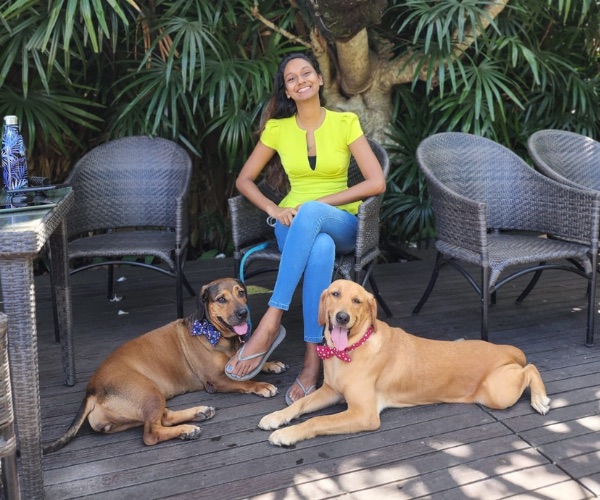
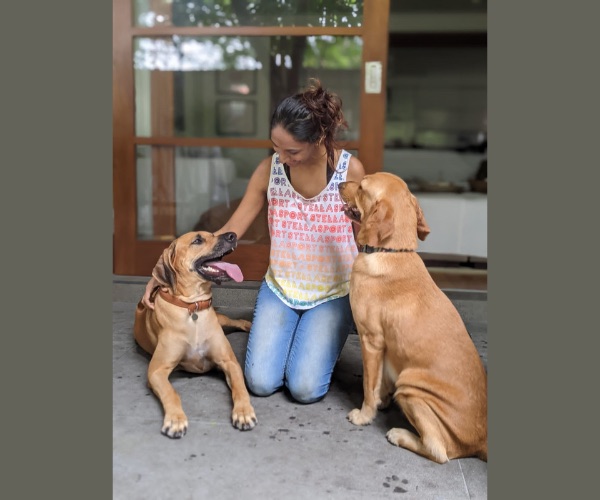
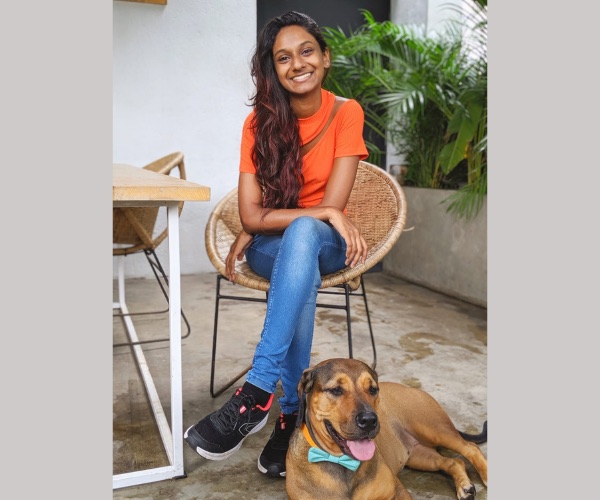
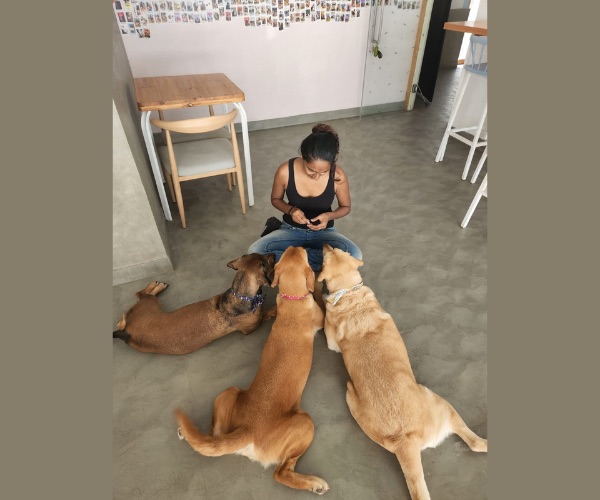
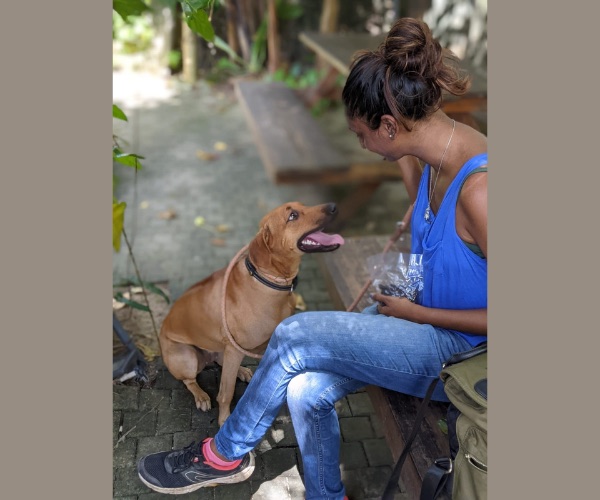
Luna and Ira were seated patiently, despite an occasional bout of excitement as a response to faint noises from the surroundings. Both these dogs were trained by Terunie Senanayake to behave while adults engage in a conversation. As a result of having a complicated relationship with her previous street dog Rusty, Senanayake was determined to study dog training and behaviour to help dogs get out of their aggression and anxiety with love and affection. Today, as the founder of Pet’iquette, she spends most of her time training dogs to socialize and be well-behaved dogs when they go out.
In an interview with Women at Work, Senanayake spoke about dog psychology, the do’s and don’ts when training a dog, why breeding regulations need to be implemented and why it’s important to teach people about the responsibilities of pet ownership.
Excerpts :
Q Tell us about you and how you were inspired to become a dog trainer and behaviourist?
I have been doing this for almost 6 years now and I’m both US and UK certified. I do basic training and I also deal with behavioural issues like aggression and anxiety which are fairly new problems to be dealt with in Sri Lanka when it comes to dogs. When I was in my teens I rescued Rusty, my dog off the streets; he was a darling, but as he grew older he became very aggressive. I had absolutely no experience with dogs at the time. A lot of things went wrong. The first mistake I made was rescuing him when he was around three weeks old (they should be with their parents until they are at least eight weeks old). He was unruly, destroyed couches, and mattresses and as time went on he started getting aggressive. He has bitten everyone in my family. So began my search.
I went to different trainers to get help and none of them offered the kind of help I was looking for. I wanted someone to explain why this aggression is happening and what I could do to stop it without using force. I may have gone to around 3-4 trainers and one of them explained that he was going to beat the dog in order to train him. I decided that the best option was to learn how to train him myself. At the time I was doing CIM and I happened to meet another certified behaviourist and she was lovely. She had the skills and knowledge I was looking for but by that time I had decided that this is what I wanted to do as a career.
I did research on different courses and thankfully because I could pair my learning with the hands-on experience I was getting from working with her, I didn’t have to go abroad. The experience I gained was immeasurable. I learned to work with a variety of breeds, sizes and issues. As of now, I must have worked with easily over 500 dogs. Initially, I did a UK course on basic training, grooming, and basic health problems and then I did an American course focusing on dog psychology; learning how they think and feel. This is what helped me to work with more advanced issues.
Q Let’s talk about Pet’iquette and the services offered...
At Pet’iquette my focus is to help owners understand and work with their own dogs so that their relationship gets stronger. That was what was missing in my previous relationship with Rusty. I couldn’t understand him and vice versa and therefore I wasn’t able to give him the guidance he needed to keep him happy, thrive and lead the best life he could. Therefore I want to give owners the ability to work with their dogs. Dogs love to work. they need that physical and mental stimulation. The services I offer are structured training sessions where I work with owners whether in person or online to guide them on how they can live the best life with their furry BFF.
The reason I don’t take dogs on and train them at my place is that the dog develops a relationship with me and not the owner. Therefore there’s a gap when the dog is given back to the owner.
Another service I offer is proper socialization. Socialization is positive exposure to noise, people, animals and new places resulting in co-existence, owner-centred focus, calmness and unreactivity. This helps you have a dog that you can take anywhere. It helps prevent aggression and helps you form that fairy tale relationship with your dog.
Q What are the instances when dogs get anxiety?
Lack of socialization, abuse, neglect, and sometimes it’s a part of their temperament or could even be hereditary.
Q What are the do’s and don’ts that people should keep in mind when a dog is going through a training process?
I’d say the keys to training are communication and consistency. Make sure your dog understands what you want through clear communication. Then be consistent about what you expect. There’s also the need for consistency where other people are involved in the training whether as a bystander or actively involved in it. Everyone that interacts with the dog needs to have the same set of guidelines.
Q Let’s talk about pet-friendly cafés. There are only a few in Sri Lanka. Why should there be more such cafés?
It’s such a lovely thing to walk into a café and see a dog. It has the power to make a person’s day. The advantages to the cafés would be obviously customer loyalty. The cafés that do allow dogs get so much social media recognition and once word spreads that dogs are allowed at a particular restaurant within the dog owner community, it guarantees repeat customers.
Another benefit is that it really creates a positive, homely atmosphere at the restaurant. Owners at different tables now have a reason to chat to one another as they look admiringly at each other's dogs. And we all need that pleasant experience in these hard times. The more well-behaved dogs are incorporated into our lives, the better our lives become.
Q Can stray dogs be trained the same way as dogs of other breeds?
Yes! Because dogs as a species think the same way. While some dogs like German Shepherds were bred for specific purposes, street dogs weren’t bred by anybody. When people initially bred dogs, they would focus on choosing dogs that have the particular temperament or drive they were looking for and so those instincts got stronger. But in all these breeds one main thing they were bred for was a need to take direction from people. Street dogs don’t have that. But that doesn’t in any way mean that they are less smart nor does it mean that they can’t take direction. It means that they are more independent and so we need to give them something to work for. Much like how most people wouldn’t work without a salary.
Q Let’s talk about dog breeding and why regulations need to be prioritized.
There are no breeding regulations in Sri Lanka and so there’s a lot of overbreeding and inter-breeding. Breeding abroad - there is a very meticulous process. They choose the parents over generations, they do regular health checks for hereditary and possible diseases and they do temperament testing. If a dog in a particular line is aggressive they don’t breed that dog. If there is any potential health problem that could come up, that dog isn’t bred. Because of that standard, they have beautiful and healthy puppies with a lovely temperament. In order to become a licensed breeder, you need to know about dog psychology as well as the medical aspect of breeding. Dog care is the most important thing to those breeders.
For example, from the time they are born until they are 8-12 weeks, puppies learn new things every single week. The mother teaches them bite inhibition, how to communicate with other dogs, and how to deal with people. So a good breeder knows that a puppy needs to stay with their mom and littermates until they are at least 8 weeks old.
Did you know that training actually starts with the breeder? Each week the pup is with them, they gradually introduce the pups to new sights, smells, sounds and experiences so that they grow up to be well-balanced, calm dogs. That’s why breeding regulations are so important. A lack of knowledge on both the parts of breeders and owners is a major reason why we have many dogs with behavioural issues in Sri Lanka. Here, It’s very commercial. Since a lot of people do it for money, parents are kept in tiny cages 24/7 in their own waste and in the worst conditions. Many puppies that come from these breeders die. It's really a terrible crime.
Q What more should be done to encourage more females to become dog trainers and behaviourists?
I know of three women who are dog trainers. But when I started all the trainers I contacted were males. It used to be a male-dominated industry but as I know now, the only two certified trainers are female, myself included. There’s a little bit of stigma against women. But I must say since recently I have gotten a lot of respect and people have been very supportive. There’s nothing to stop a woman from becoming a dog trainer and/or behaviourist.
Q What is the most satisfying and most challenging part about being a dog trainer?
I wake up every morning thinking yay! I get to work with dogs today. ! It’s about doing what you love to do. With dogs, it’s always love. There’s no judgement, criticism and nothing negative. It is stressful. A lot of people think that being a dog trainer is only about playing with puppies. But there’s more to it than that. When working with aggression or anxiety it takes a lot of effort and you’re constantly on edge because there are very few factors you can control when training in real-life situations... It’s an interesting job because no two cases are the same but it can definitely be stressful sometimes.
Q Your message to the people about changing their perception about having dogs.
It’s a lifelong commitment. Dogs have so much potential. Luna has worked with an autistic child, elderly people etc., and they really enhance our lives. They are not meant to be locked in cages and mistreated. If you give them what they need to thrive, you will benefit in numerous ways. If you don’t have knowledge, time, energy and health to look after a dog, then don’t adopt a dog.
Q Future aspirations
As a short-term goal, I want to get a pool as swimming is a healthy form of exercise for dogs. My long-term goal is to try and teach people the responsibility of having a dog. I want to change people’s perception of looking at dogs as a possession, status symbol or a breeding machine and see them as living, breathing, beautiful sources of pure love and enjoyment.
pics courtesy Terunie
0 Comments